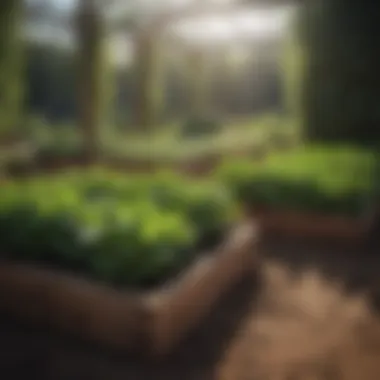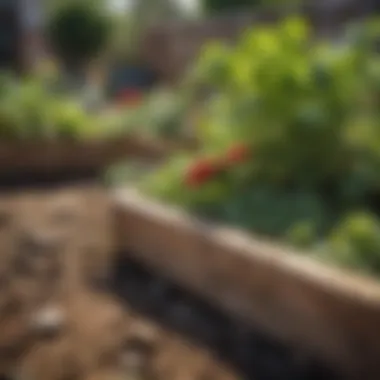Exploring the Benefits of Raised Vegetable Beds with Covers


Intro
Raised vegetable beds with covers present a modern solution to a timeless challenge: cultivating fresh produce in an efficient manner. They offer numerous advantages, which make them a compelling choice for both novice and experienced gardeners. This section outlines the primary reasons why these gardening innovations merit a closer inspection.
One of the most significant benefits is the ability to control environmental conditions. Covers can regulate temperature, retain moisture, and protect plants from harsh weather or pests. This predictable environment enhances growth cycles, leading to higher yields.
Furthermore, the design versatility of raised beds allows for a wide range of aesthetics, promoting both practicality and visual appeal. Gardeners can choose from various styles and materials to complement their outdoor spaces.
Lastly, the maintenance needs of these beds can be simplified through strategic design and the use of covers. This article will explore the components that make raised beds an intelligent choice for sustainable gardening practices.
Design Inspirations
Trending Styles
The design of raised vegetable beds can vary significantly, influenced by personal preference and functional requirements. Height, dimension, and cover type are all vital considerations.
Some popular styles among gardeners include:
- Traditional Wooden Beds: These remain a staple due to their natural look. Pressure-treated lumber or cedar are favored materials since they are durable and resist decay.
- Metal Raised Beds: Steel or aluminum beds offer a sleek, modern appearance. They retain heat well, which can be beneficial in cooler climates.
- Recycled Materials: Creative gardeners are increasingly using discarded materials, such as pallets or old bricks, providing a sustainable alternative. This not only reduces waste but also offers a unique aesthetic.
Color Palettes
Colors in gardening extend beyond plants. The tones of the raised beds themselves can affect the ambiance of the garden.
Some designers recommend:
- Natural Wood Brown: This color often blends seamlessly with the garden's environment.
- Bright Colors: Applying a coat of paint in hues like red or blue can add whimsy and vibrancy to the space.
- Neutral Shades: Shades like gray or beige help highlight the plants while staying understated.
Choosing the right palette enhances the overall garden aesthetic and inspires creativity.
Maintenance and Upkeep
Seasonal Maintenance Checklist
Maintaining raised vegetable beds ensures longevity. Here are essentials to consider for each season:
- Spring: Inspect for damage, add fresh soil or compost, and plant seeds or seedlings.
- Summer: Monitor for pests, ensure adequate watering, and check covers for wear.
- Fall: Harvest remaining crops, consider planting cover crops, and prepare for winter dormancy.
- Winter: Remove any debris, clean covers, and protect exposed soil to prevent erosion.
Cleaning and Organization Tips
Keeping raised beds organized can be as crucial as tending to the plants themselves. Here are methods to enhance cleanliness:
- Use Baskets: Implementing baskets for tools can streamline access during gardening activities.
- Label Plants: Using simple plant labels can help in identifying and taking care of different species efficiently.
- Regular Inspections: Periodically check every aspect to ensure everything remains in working order.
By adhering to these maintenance practices, gardeners enhance the resilience and productivity of their raised vegetable beds while ensuring a visually pleasing garden landscape.
Foreword to Raised Vegetable Beds
Raised vegetable beds have gained popularity among gardeners for various reasons. They offer an innovative way to cultivate plants while maximizing yield and efficiency. By elevating the soil, these beds improve drainage and can lead to healthier plants. Ths concept is particulary advantageous in areas with poor soil conditions or limited space.
The design of raised beds also allows for better control over soil quality and composition. Gardeners can choose specific soil types suited for different plants, fostering an ideal growing environment. Additionally, raised beds are often easier to access, minimizing strain on the back and knees.
Notably, implementing covers on raised beds can further enhance their benefits. Covers serve multiple purposes, from temperature regulation to pest protection. This aspect encourages year-round gardening and can significantly extend the growing season.
Definition and Overview
Raised vegetable beds are elevated planting structures typically made of wood, stone, or other durable materials. They contain soil and create a defined growing area that is usually framed. The height of these beds can vary but typically ranges from eight to twelve inches. This increased height allows for easier planting, weeding, and harvesting.
In contrast to traditional gardens, raised beds bring an organized approach to gardening. Each bed can host a different type of vegetable or plant, allowing for crop rotation and better management of resources.
History and Adoption
Historically, the concept of raising garden beds can be traced back to ancient civilizations. The Egyptians and Romans utilized elevated planting techniques, recognizing the advantages of improved drainage and soil conditions. In modern times, these practices have been embraced widely by both amateur gardening enthusiasts and professional farmers.
The adoption of raised beds has increased, particularly in urban environments, where space is limited. Communities have turned to raised beds to transform small yards, patios, and balconies into productive garden spaces. The popularity is also linked to the rise of organic gardening and sustainable practices, as raised beds offer a simple way to grow fresh produce. Gardening organizations and resources today facilitate this trend, educating novice gardeners about the benefits and techniques associated with raised beds.
The Importance of Covers for Raised Beds
Using covers on raised vegetable beds is not just a choice; it is an essential practice that carries substantial weight in modern gardening. Covering the beds serves several purposes that interplay to foster a healthier environment for plants. Temperature regulation, pest protection, and soil moisture retention are three significant aspects that elevate the efficiency of these garden systems.
Temperature Regulation
One of the most notable benefits of using covers is the ability to regulate temperature. Raised beds tend to warm up quicker in the spring compared to traditional ground gardening, thanks to their elevated position. However, covering these beds provides an additional layer of warmth, particularly during colder nights or early spring frosts.


Covers can trap heat and create a microclimate where plants flourish. This method allows for an extended growing season, enabling gardeners to plant earlier in spring and harvest later in fall. Materials like row covers, cold frames, or even greenhouse plastics can promote a stable temperature range which is crucial for seed germination and plant growth.
"Using covers on raised vegetable beds can significantly prolong the growing season, enabling gardeners to optimize yield throughout the year."
Pest Protection
Covers also serve as formidable barriers against pests. Insects such as aphids and caterpillars can wreak havoc on young plants, leading to stunted growth and decreased yields. By placing a cover over raised beds, gardeners create a protective shield that deters these pests from accessing the vegetables.
While barriers are effective, venting is an important consideration. Covers must allow for air circulation to prevent humidity build-up, which can lead to disease. Techniques like using mesh cloth or specialized insect netting can provide both pest protection and necessary airflow. This balance is critical to ensure plants remain healthy while being shielded from harmful organisms.
Soil Moisture Retention
Another vital aspect of using covers on raised vegetable beds is their ability to assist in soil moisture retention. Raised garden beds typically have soil that dries out more quickly than in-ground gardens due to exposure to air and sunlight. By employing a cover, gardeners mitigate this moisture loss.
Different types of covers can offer varying degrees of moisture retention. For instance, solid plastic covers may trap more moisture, while breathable fabrics may slow evaporation. Consistent moisture levels help plants establish strong root systems and thrive, especially during dry spells. This not only improves plant health but also reduces the frequency of watering, making gardening more efficient.
In summary, the importance of covers for raised beds transcends mere aesthetics. They play a critical role in enhancing temperature, protecting against pests, and retaining soil moisture. Engaging with these advantages can significantly impact a gardener's success, making covers a practical investment for anyone looking to optimize their vegetable gardening experience.
Types of Covers for Raised Vegetable Beds
The use of covers for raised vegetable beds is essential in modern gardening practices. Each type of cover has its own benefits and unique applications. Understanding the different types can significantly enhance the gardening experience. Covers provide protection against various environmental factors, extend the growing season, and can increase yields. Choosing the right one depends on specific needs, climate, and types of crops grown.
Row Covers
Row covers are lightweight fabrics that provide warmth and protection to plants. They allow sunlight, moisture, and air to pass while safeguarding against insects and harsh weather conditions. These covers are particularly beneficial for early and late-season crops, as they can trap heat and create a microclimate around the plants.
Benefits of row covers include:
- Frost Protection: Helps prevent frost damage during cold nights.
- Pest Deterrent: Acts as a barrier against pests such as aphids and beetles.
- Wind Protection: Shields delicate seedlings from strong winds.
It is important to choose the right types of row covers based on the plants' needs. For example, some row covers are more permeable than others, providing different levels of protection and warmth.
Cold Frames
Cold frames are structures that provide a sheltered environment for plants. They can be constructed using wood or a pre-made kit, with the top usually made of glass or transparent plastic. Cold frames function by absorbing sunlight and retaining warmth, making them ideal for starting seedlings or extending the growing season for certain vegetables.
The advantages of using cold frames include:
- Temperature Regulation: Keeps plants warmer than the outdoor environment.
- Soil Warmth: Warms the soil for quicker germination and growth.
- Extended Harvest: Allows for the cultivation of crops that thrive in cooler temperatures.
Setting up a cold frame requires consideration of location and orientation to maximize sunlight exposure.
Cloches
Cloches are dome-shaped covers that can be made from glass or plastic. They serve a similar purpose to cold frames but are smaller and typically used to protect individual plants or small groupings. Cloches help in warming the soil and can also enhance humidity around the plants.
Key benefits of cloches are:
- Direct Protection: Shields young plants from frost and pests.
- Microclimate Creation: Offers localized warmth and moisture.
Cloches can be moved easily, allowing gardeners to adapt to changing weather conditions.
Shade Cloths
Shade cloths are designed to filter sunlight and reduce heat, making them essential for protecting plants during hot weather. These covers come in various densities, allowing gardeners to select an appropriate level of shade based on the specific plant variety and climatic conditions.
Benefits of using shade cloths include:
- Heat Protection: Reduces stress on plants during extreme heat.
- UV Protection: Prevents sunburn and damage to sensitive plants.
- Humidity Control: Helps maintain adequate moisture levels in the soil.
When placing shade cloths, it's crucial to ensure proper ventilation to prevent overheating.
Design Considerations for Raised Beds with Covers
In the realm of gardening, especially with raised vegetable beds equipped with covers, design considerations play a pivotal role in the success of cultivation efforts. Proper design impacts not only aesthetics but also functionality, ensuring the beds serve their intended purpose effectively. This section elucidates key elements such as dimensions, material selection, and structural framework, all of which contribute to optimizing growth and sustainability.
Dimensions and Height
The dimensions and height of raised beds with covers are fundamental aspects that influence plant health and yield. A raised bed typically ranges from 6 to 30 inches in height. The ideal height often depends on the types of plants being grown. For deep-rooted vegetables like carrots or parsnips, a taller bed allows for optimal root expansion. Conversely, for shallow-rooted crops such as lettuce, a lower profile may suffice.
When designing raised beds, consideration of length and width is crucial. For instance, a width of 4 feet allows for easy access from both sides without stepping into the soil, thus avoiding soil compaction. Length can vary based on available space, but longer beds often allow for greater crop rotation and diversity.
Materials Selection
The choice of materials is equally important in constructing raised beds with covers. Common materials include wood, metal, and composite boards. Each material has distinct advantages and disadvantages.


- Wood: Often favored for its natural appearance, wood is readily available and can be harvested sustainably. However, untreated wood may rot over time. Thus, it may need to be replaced more frequently.
- Metal: Metal beds are durable and can be insulated for temperature control. Steel provides longevity but comes with potential rust concerns unless coated properly.
- Composite boards: These are a blend of recycled material and plastic, resistant to rotting and insects. While they have environmental benefits, they may not offer the classic garden aesthetic.
Selecting the right material often depends on budget, aesthetics, and intended plant type. Durability and maintenance requirements should also guide decisions.
Framework for Supporting Covers
The framework that supports the covers is essential for ensuring stability and effectiveness in protecting the crops within. A robust support system caters to a variety of cover types, such as cold frames or row covers. The framework can be constructed from various materials, including wood or PVC piping.
- Wooden frames: These offer rigidity and can be built to custom dimensions, fitting snugly over the raised bed. Moreover, they can be enhanced with additional support structures to withstand wind or heavy precipitation.
- PVC piping: This lightweight alternative allows for easy adjustments and can be bent to create arches. The flexibility of PVC makes it a popular choice for gardeners looking to quickly build and dismantle supports as needed.
A well-designed framework should facilitate easy access for maintenance while securing the cover firmly against environmental factors. Therefore, careful planning and execution in creating this structure can significantly enhance the productivity of raised vegetable beds.
Cultivation Techniques in Covered Raised Beds
Cultivating vegetables in raised beds that are covered can lead to a more productive and manageable gardening experience. The framework of raised beds provides better control over the growing environment, while covers can enhance this by stabilizing temperature and humidity levels. Understanding the specific cultivation techniques in these beds is essential for maximizing yield and ensuring healthy plants.
Crop Rotation Strategies
Crop rotation is a critical practice that helps maintain soil health and prevent disease build-up. In covered raised beds, it is possible to implement a systematic rotation of crops to improve nutrient use and reduce pest and disease issues. A simple strategy involves grouping plants by families. For instance, planting legumes like beans in one season can restore nitrogen in the soil, much needed for the following crop cycle.
- Yearly Rotation: Change the crop at least once per growing season to avoid soil depletion.
- Plant Families: Rotate between different plant families; for instance, follow carrots with onions to avoid nematodes.
- Seasonality: Utilize different seasonal crops to ensure there is something growing year-round while allowing the soil to rest.
Companion Planting Essentials
Companion planting involves placing different plants together to boost growth and deter pests. When using covered raised beds, this strategy becomes more effective as the controlled environment allows for better management of sunlight and moisture. Plants such as basil and tomatoes grow well together, enhancing each other's development. Specific pairings can add beneficial characteristics to the garden and create a natural pest deterrence system.
- Deterrence: Marigolds can repel nematodes and aphids, making them great companions for various vegetable crops.
- Enhancing Growth: Planting carrots with onions can increase growth rates as their scents uniquely confuse pests that damage each other's roots.
- Residual Benefits: Some plants provide shade or ground cover, mitigating soil temperature fluctuations that arise without covers in extreme climates.
Soil Management Practices
Managing soil health in covered raised beds requires intentional practices that maintain fertility and structure. The cover can help retain moisture and warmth, which influences the efficiency of other soil management techniques. It is vital to incorporate organic matter, such as compost, to ensure a rich nutrient profile for the vegetables planted.
- Regular Testing: Conduct soil tests annually to know pH and nutrient levels accurately.
- Organic Additives: Regularly mix in compost or well-rotted manure to enrich the soil microbiome.
- Mulching: Applying organic mulches can reduce weeds and conserve soil moisture.
Seasonal Considerations for Covered Raised Beds
Understanding the seasonal dynamics of covered raised beds is essential for successful gardening. Each season presents unique challenges and opportunities. By considering the timing and conditions specific to spring, summer, and fall, gardeners can make informed decisions about planting, maintenance, and preparation. This section offers practical strategies that enhance productivity while taking the environmental factors into account.
Spring Planting Strategies
Spring is a critical period for gardeners with covered raised beds. During this time, temperature fluctuations can affect seedlings. Using row covers can create a microclimate that promotes early growth. When planting in spring, it is vital to select hardy crops that can withstand cool temperatures and variable moisture levels.
- Timing: Start planting as soon as the soil can be worked. Consider using a soil thermometer to ensure warm enough conditions.
- Crop Selection: In early spring, vegetables like peas, lettuce, and radishes are suitable. They germinate well in cooler temperatures.
- Soil Preparation: Ensure the soil is rich in organic matter. Compost can greatly enhance soil health and moisture retention.
- Cover Utilization: Employ light row covers early in the season to protect young plants from frost. This will encourage germination and vigor.
"Successful spring planting in raised beds requires careful attention to temperature and crop selection."
Summer Maintenance and Growth
As summer approaches, the focus shifts to maintaining the health of plants already established in covered raised beds. This season demands attention to moisture levels and protection against pests and diseases. It is also a time to monitor growth closely.
- Watering Regime: Regular checks on soil moisture are crucial. Raised beds often dry out faster than in-ground gardens. Consider a drip irrigation system for efficiency.
- Pest Management: Inspect plants for signs of pests regularly. Covered beds offer some protection, but vigilance is still necessary. Introducing beneficial insects can aid in pest control.
- Fertilization: Apply a balanced organic fertilizer in mid-summer to support health and growth. This helps in maintaining nutrient levels as crops mature.
- Pruning and Support: For taller plants, ensure that there is adequate support. This helps to reduce disease and improves air circulation.
Fall Preparations for Winterization
As cooler temperatures set in, preparing covered raised beds for winter is crucial. This step ensures crops can survive until the frost and sets the stage for early spring planting the following year.
- Harvesting: Collect remaining crops before the first frost. Use covers to extend the harvest period when possible.
- Soil Enrichment: After harvesting, incorporate organic amendments into the soil. This can include compost or green manure crops that enrich the soil.
- Covering Plans: Utilize heavy row covers or cold frames to protect winter crops. This aids in extending the growing season into late fall and even early winter.
- Tool Maintenance: Clean and store tools properly to ensure longevity. Check and repair any covers or structures used during the season.
Ensuring that the gardening cycle transitions smoothly from one season to the next is integral for sustained productivity. These seasonal considerations provide a comprehensive framework for maximizing yield while minimizing risk.
Maintenance of Raised Beds and Covers
Maintaining raised beds and their accompanying covers is essential for successful gardening. Proper maintenance not only ensures a healthy growing environment for the plants but also prolongs the life of the raised beds and covers. Neglecting these tasks can lead to a decline in plant health, decreased yields, and costly repairs or replacements.
Regularly inspecting your raised beds and their covers helps in identifying issues early. This proactive approach allows gardeners to address problems such as wear and tear, pest infiltration, or drainage concerns. By adopting a routine, you can keep your garden thriving and mitigate potential complications.
Regular Inspection Protocols
Conducting regular inspections is crucial for maintaining the integrity of both the raised beds and their covers. Inspecting should be done at least once a month during the growing season, and more frequently during extreme weather conditions. Here are some key aspects to consider during inspections:
- Structural Integrity: Look for signs of deterioration in the raised bed materials. Check for cracks, rot, or warping in wooden beds, and ensure that metal and plastic structures are not rusting or becoming brittle.
- Cover Condition: Examine the covers for tears or holes that could permit pests or harsh weather elements to penetrate. Ensuring that covers are intact is vital for temperature regulation and pest control.
- Pest Activity: Observe for any signs of pests like aphids or caterpillars. Early detection can make pest management much more successful.
- Soil Health Checks: Remove the cover temporarily to check soil moisture and texture. Healthy, well-aerated soil is essential for plant growth.
Creating a checklist for these inspections can enhance your efficiency and ensure no critical factors are overlooked.


Cleaning and Repair Techniques
Keeping your raised beds and covers clean is just as important as inspecting them. Dirt, mold, or debris can harbor pests and diseases. Here are some effective cleaning strategies, along with repair tips:
- Cleaning Raised Beds: Use a gentle soap and water solution to clean the inner sides of wooden beds. For plastic or metal raised beds, rinse with a hose to remove any build-up. Avoid harsh chemicals that may harm beneficial organisms in the soil.
- Maintaining Covers: Depending on the type of cover, rinse thoroughly to remove dirt and dust. If fabric covers are stained or appear unhealthy, consider replacing them. Make sure to dry them when not in use to prevent mold growth.
- Repairing Damage: Small tears in fabric can be stitched or patched using fabric adhesives. For plastic covers, clear tape can be effective for minor repairs. Replace severely damaged covers rather than attempting to patch repeatedly.
- Sealing Wood: For wooden raised beds, consider applying a non-toxic sealant every couple of years to minimize rot and prolong life.
By adhering to a schedule of regular inspections and cleaning, you can maintain a productive and healthy gardening environment. Keeping an eye on these aspects allows for better yields and a more rewarding gardening experience.
"Regular maintenance of raised beds ensures a productive gardening ecosystem, where plants can truly flourish."
By incorporating these practices into your gardening routine, you can maximize your success with raised beds and covers.
Environmental Impact of Covered Raised Beds
Understanding the environmental impact of covered raised beds is crucial for gardeners. This section will discuss how these gardening systems contribute positively to soil health and biodiversity as well as promote water conservation methods. Exploring these elements allows for a comprehensive insight into sustainable gardening practices.
Soil Health and Biodiversity
The arrangement of raised vegetable beds inherently promotes better soil health compared to traditional planting methods. Raised beds typically have improved drainage and aeration. This structure prevents soil compaction, which is common in conventional gardening. Healthier soil supports diverse microbial activity, which is vital for nutrient cycling. Using organic methods and avoiding chemical fertilizers can further enhance this interaction, fostering a balanced ecosystem.
Biodiversity is also greatly impacted by the use of covered raised beds. When different plant species are used side by side, it creates a micro-habitat for various beneficial insects and microorganisms. This is especially important in the context of pest control. For example, companion planting not only increases crop variety but helps maintain the ecological balance, reducing reliance on synthetic pesticides.
"A diverse garden ecosystem is more resilient and less prone to disease and pest invasions."
Moreover, covers help extend the growing season for many vegetables. They allow for early planting in spring and continued production in the fall. This extended growth period increases the amount of organic matter returned to the soil, further enriching its health. Hence, focusing on soil health and biodiversity is fundamental for gardeners aiming to create a sustainable gardening environment.
Water Conservation Methods
Water conservation is another significant benefit of covered raised beds. Using covers can substantially reduce evaporation rates. During hot weather, plants silhouetted under row covers or shade cloths retain moisture effectively, requiring less frequent watering. This is particularly important in areas prone to drought.
There are various techniques to enhance water conservation in covered raised beds:
- Mulching: A layer of organic mulch helps retain moisture and suppress weeds.
- Drip Irrigation: This technique delivers water directly to the plant roots, minimizing waste.
- Rainwater Harvesting: Setting up a system to collect rainwater can provide an efficient source of irrigation.
Integrating these methods not only conserves water but also contributes to reducing the overall environmental footprint of gardening activities. This is an essential consideration, especially in the face of climate change. Homeowners and gardeners can adapt these strategies to cultivate a garden that is both productive and environmentally responsible.
In summary, the environmental impact of covered raised beds reflects a commitment to sustainable practices. Soil health and biodiversity are enhanced, while effective water conservation measures can significantly reduce resource waste. As such, adopting these gardening techniques can lead to a fruitful and eco-friendly gardening experience.
Challenges Associated with Raised Beds with Covers
Raised vegetable beds provide distinct advantages for gardeners, especially when equipped with covers. However, as with any method, there are challenges that warrant careful consideration. Understanding these challenges is crucial for maximizing the potential of covered raised beds. Each issue requires thoughtful solutions to ensure a productive gardening experience for homeowners and gardening enthusiasts alike.
Cost Considerations
Creating raised beds with covers can come with a significant financial investment. The initial costs involve materials such as wood, soil, and cover types. For example, high-quality lumber, like cedar or redwood, can be expensive but might offer longer durability compared to less expensive options. Additionally, if opting for specialized coverings such as cloches or interconnected cold frames, the prices can also add up quickly.
Moreover, ongoing maintenance costs should not be overlooked. Pest control solutions, soil amendments, and seasonal cover replacements can add financial pressure. It is essential to calculate these costs accurately against the benefits of increased yield and longer growing seasons. Homeowners must plan their budgets accordingly to avoid unexpected expenses.
Material Durability
Durability of materials selected for the raised beds is another significant challenge. Many sustainable materials can eventually degrade due to exposure to weather and moisture. For instance, rubberized or synthetic covers may wear out faster than anticipated, requiring replacements. This can lead to more frequent spending and labor costs. Choosing the right food-safe materials is vital. Consider investing in high-quality weather-resistant material for coverings that can withstand the elements.
There are several options to consider:
- Natural wood is aesthetically pleasing but may rot over time. Treating it with preservatives can extend its lifespan.
- Metal frames can provide strong support but might require insulation to avoid overheating in summer.
- Plastic materials are lightweight and generally resilient but can become brittle over time.
Pest Resistance Adaptations
Pest management in covered raised beds can present unique challenges. While covers can protect against some pests, others may find ways to penetrate or thrive underneath. For instance, aphids and spider mites can still infest crops if covers are not secured adequately. Thus, adaptations in pest resistance are necessary.
Gardeners should consistently monitor for signs of infestation even when using covers. It might also be beneficial to complement physical barriers with organic pest control methods. Utilizing beneficial insects, such as ladybugs or lacewings, can help maintain a balanced ecosystem. This integrated pest management approach can serve to reduce reliance on chemical pesticides, ultimately preserving the environment.
Epilogue: The Future of Gardening with Raised Beds and Covers
The topic of raised vegetable beds with covers represents a significant evolution in gardening practices. This approach brings forth a variety of benefits, such as improved yields, extended growing seasons, and enhanced pest management. Not only do covered beds protect crops from adverse weather conditions, but they also provide a controlled environment that promotes healthier plant growth.
Innovative Practices and Technologies
As gardeners seek to maximize productivity and sustainability, innovative practices and technologies are essential. One emerging practice is the integration of smart gardening tools. These tools allow gardeners to monitor moisture levels, temperature, and plant health through smartphone applications. For instance, moisture sensors can provide real-time data, enabling more efficient watering practices.
Furthermore, advancements in materials science have led to the development of better-quality covers. These include lightweight and durable fabrics that offer UV protection while allowing necessary air circulation. Biodegradable plastics, for instance, can serve as temporary covers while decomposing naturally, thus reducing plastic waste in the environment.
Some gardeners are also experimenting with hydroponic systems within raised beds. This method optimizes space and resource usage by growing plants in nutrient-rich water rather than soil. It is particularly useful in urban settings where space is limited.
Encouragement for Adaptation
Seasonal adaptability is crucial for the success of gardening with raised beds and covers. Gardeners are encouraged to embrace a flexible mindset. Understanding local climate patterns and evaluating the suitability of specific crops can lead to better outcomes. To facilitate this, gardeners should grow a variety of plants that thrive in different conditions.
Moreover, participating in local gardening communities can provide invaluable insights. Sharing experiences, techniques, and best practices can help gardeners learn from one another. Online forums such as Reddit and dedicated gardening groups on Facebook serve as platforms for this community engagement.
In summary, the future of gardening with raised beds and covers lies in innovative practices, sustainable materials, and community collaboration. By embracing these elements, gardeners can cultivate more resilient and productive gardens, ultimately transforming their gardening experience.







